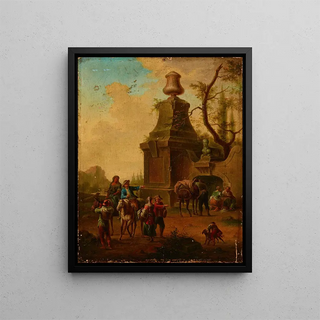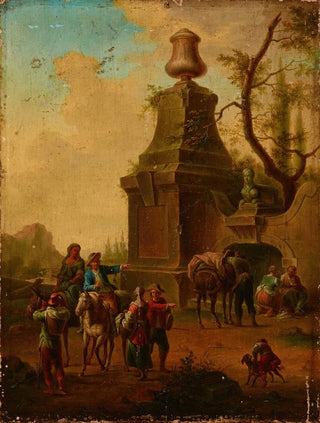Art print | At the source - Franz de Paula Ferg


View from behind

Frame (optional)
In the rich and captivating universe of art history, certain works stand out for their ability to capture moments of timeless beauty. "At the Source - Franz de Paula Ferg" presents itself as an open window to a world of serenity and contemplation. This painting, imbued with delicacy, transports us to an idyllic landscape where nature and humanity meet. By observing this piece, the viewer is invited to immerse themselves in a universe where time seems suspended, where every detail is an invitation to daydream. The soft light emanating from the canvas evokes a peaceful atmosphere, conducive to meditation and escape.
Style and uniqueness of the work
Franz de Paula Ferg's style is distinguished by his ability to blend realism and impressionism. In "At the Source," the delicate nuances of color and the finesse of the strokes demonstrate undeniable technical mastery. The depiction of the characters, while imbued with realism, reveals a certain poetry. The human figures, though modest in their posture, seem to vibrate with an inner life, as if in communion with the surrounding nature. The interplay of light and shadow, carefully orchestrated, creates an almost tangible atmosphere where the viewer can almost hear the whisper of the water and the song of the birds. This work stands out for its visual harmony, where each element finds its place in perfect balance.
The artist and his influence
Franz de Paula Ferg, Austrian artist of the 19th century, established himself as an emblematic figure of his era. His ability to translate human emotions through enchanting landscapes profoundly marked his contemporaries. Influenced by the Romantic movement, Ferg captured the beauty of nature while exploring human feelings. His works, often imbued with melancholy, reflect a quest for harmony between man and his environment. Through his paintings, he invites the viewer to feel the beauty of the world around them, to marvel at the simplicity of everyday scenes. His artistic legacy continues to inspire many contemporary artists, who see in him a pioneer of this

Matte finish

View from behind

Frame (optional)
In the rich and captivating universe of art history, certain works stand out for their ability to capture moments of timeless beauty. "At the Source - Franz de Paula Ferg" presents itself as an open window to a world of serenity and contemplation. This painting, imbued with delicacy, transports us to an idyllic landscape where nature and humanity meet. By observing this piece, the viewer is invited to immerse themselves in a universe where time seems suspended, where every detail is an invitation to daydream. The soft light emanating from the canvas evokes a peaceful atmosphere, conducive to meditation and escape.
Style and uniqueness of the work
Franz de Paula Ferg's style is distinguished by his ability to blend realism and impressionism. In "At the Source," the delicate nuances of color and the finesse of the strokes demonstrate undeniable technical mastery. The depiction of the characters, while imbued with realism, reveals a certain poetry. The human figures, though modest in their posture, seem to vibrate with an inner life, as if in communion with the surrounding nature. The interplay of light and shadow, carefully orchestrated, creates an almost tangible atmosphere where the viewer can almost hear the whisper of the water and the song of the birds. This work stands out for its visual harmony, where each element finds its place in perfect balance.
The artist and his influence
Franz de Paula Ferg, Austrian artist of the 19th century, established himself as an emblematic figure of his era. His ability to translate human emotions through enchanting landscapes profoundly marked his contemporaries. Influenced by the Romantic movement, Ferg captured the beauty of nature while exploring human feelings. His works, often imbued with melancholy, reflect a quest for harmony between man and his environment. Through his paintings, he invites the viewer to feel the beauty of the world around them, to marvel at the simplicity of everyday scenes. His artistic legacy continues to inspire many contemporary artists, who see in him a pioneer of this






